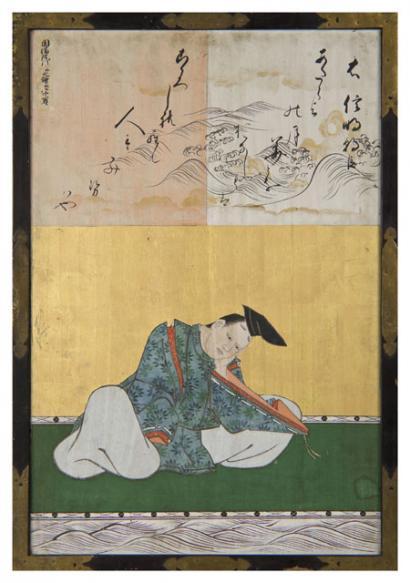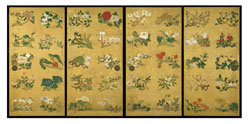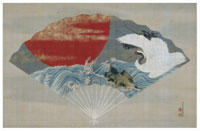
Portrait of 36 Immortal Poets
Kano Tanyu, Kano Naonobu, Kano Yasunobu
Edo period (1648)
Color and gold leaf on wooden panel
Ensemble of 36 panels. Each panel: H. 63, 6 cm; w. 41, 6 cm
Sanctuary of Konpira, island of Shikoku, Japan
© Keiichi Kawamura/ KOTOHIRA-GU
|
|
MUSÉE NATIONAL DES ARTS ASIATIQUES GUIMET
6 place d'Iéna - 75016 PARIS
INFORMATION:
Tel: 01 56 52 53 00
Website: www.guimet.fr
OPENING HOURS:
Open every day except for Tuesday, from 10 AM to 6 PM.
Tickets sold until 5:30 PM and rooms close at 5: 45 PM.
ADMISSION PRICE:
Admission for the exhibition alone: 7 € (full rate), 5 € (reduced rate).
Joint admission (museum + exhibition): 8.50 € (full rate); 6 € (reduced rate).
GENERAL COMMISSARY:
Jean-François Jarrige, member of the Institute and Professor Takashina Shûji, Tokyo University. Takubo Kyôji, cultural counselor of Konpira-San.
CURATOR:
Hélène Bayou, chief heritage curator at the musée national des arts asiatiques Guimet.
PRESS CONTACTS:
Hélène Lefèvre, Chief of the communication service.
Tel. 01 56 52 53 32 Fax 01 56 52 53 54
E-mail: helene.lefevre@guimet.fr
Sophie Maire, Jr press officer.
Tel. 01 5 52 54 11
E-mail: sophie.maire@guimet.fr

|
This exhibition, jointly organized by the office of Kotohira-gû and the Guimet museum is part of the commemoration of the 150th anniversary of diplomatic relations between France Japan. It is the perfect opportunity to admire major works from the XVIIIth century and to talk about Shintoism, the animist type religion proper to the Japanese archipelago.
A sacred site on the island of Shikoku
The Shinto sanctuary of Konpira (or Kotohira-gû), a crossroad for the cult of the mountain and beliefs linked to the divinity that guarded sea transports and protected from the dangers of the sea, was since the time of Heian (794-1185) an important center of devotion, attended in particular as of the XVIIth century. A song that tells of the pilgrimages of boats from Konpira that sailed Japan’s Internal Sea, bears witness to the popularity of this famous pilgrimage site. Pilgrims from all over have converged towards this town, located in the island of Shikoku, to pray in the holy place, where the quietness contrasts with the bustling of the markets and theaters.
Illustration: Flowers (Hanamarazu). Ito Jakuchu (1716-1800).
Edo period (1615-1868). 1764.
Colors and gold particles on paper. Four sliding doors, south side of the Jodan no ma, Oku-shoin.
Each panel: H. 177,5 cm; I. 91 cm.
Sanctuary of Konpira, island of Shikoku, Japan
© Keiichi Kawamura/ KOTOHIRA-GU
A treasure with over 6000 works
Konpira-san appears as a very active center of artistic creativity, that has kept inside the walls of its buildings numerous pictorial proofs of the Edo period. Both a venue of spirituality and culture, it has supported the arts and sciences since the Edo period and holds over 6000 works. The exhibition aims at showing, for the first time outside of Japan, a part of these works, most of them very large mural paintings (screens and sliding partitions) that participate in the site’s interior architecture. Their museum presentation will focus on rendering as faithfully as possible this unique dimension of the manner in which interior space is arranged in Japan, here applied to the religious sphere, in order to allow visitors to feel the spiritual world of Kotohira-gû where nature and culture are united.
Illustration: Rising sun, crane and turtle in a window fanned out
Shiba Kokan (1747-1818). Edo period (1615-1867)
Colors on silk. Scroll. H. 63,3 cm; l. 98,4 cm
Sanctuary of Konpira, island of Shikoku, Japan
© Keiichi Kawamura/ KOTOHIRA-GU
Tigers, cranes and camellias
The delicate cranes with their white necks, visible in the fresco Reeds and wild geese are side by side with paintings of majestic tigers. While screens illustrate the major currents of pictorial creation during the Momoyama period, in particular the Kanô school (Cedars and Mount Fuji, a screen attributed to Kanô Eitoku) and the school of Tosa (pair of screens illustrating scenes of Genji Monogatari by Tosa Mitsumoto), this exhibition brilliantly represents two great names in XVIIIth century painting: Maruyama Ôkyo (1733-1795) and Itô Jakuchû (1716-1800), whose famous works are considered today Important Cultural Goods. In the last part of the exhibition, the contemporary works of Takubo Kyôji, the cultural counselor of the sanctuary and a major Japanese artist who produced frescoes 4 meters tall and 25 meters long, ally delicateness and monumentality around camellias in indigo colors, the symbols of renaissance of the Kotohira-gû.
PUBLICATIONS:
Catalogue: trilingual edition in French, English and Japanese. 450 pages of which 272 in color, 32 €, distributed by RMN
Le Petit journal de l’exposition: Paris, RMN, 16 pages, 20 ill. in color, 3.50 €
|










